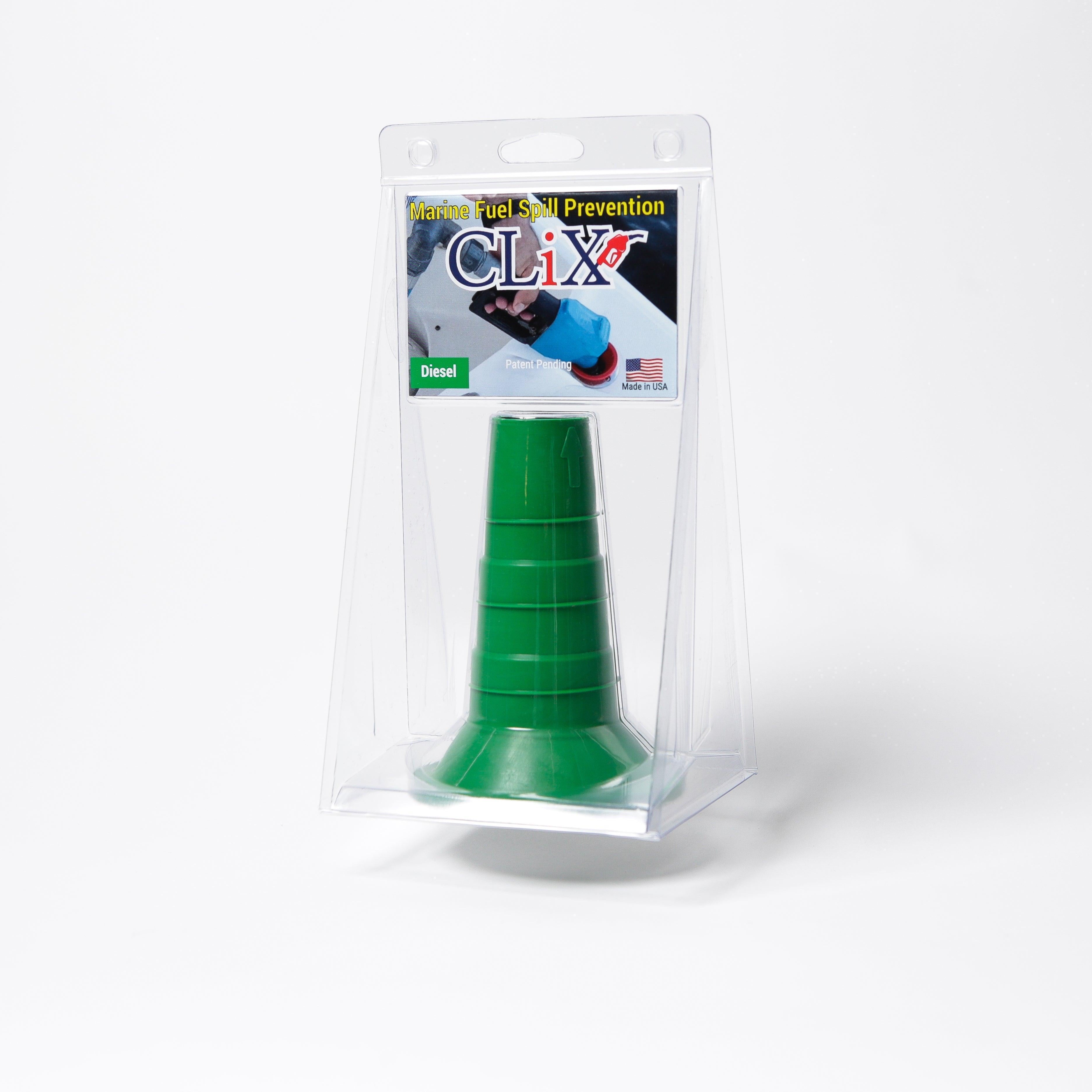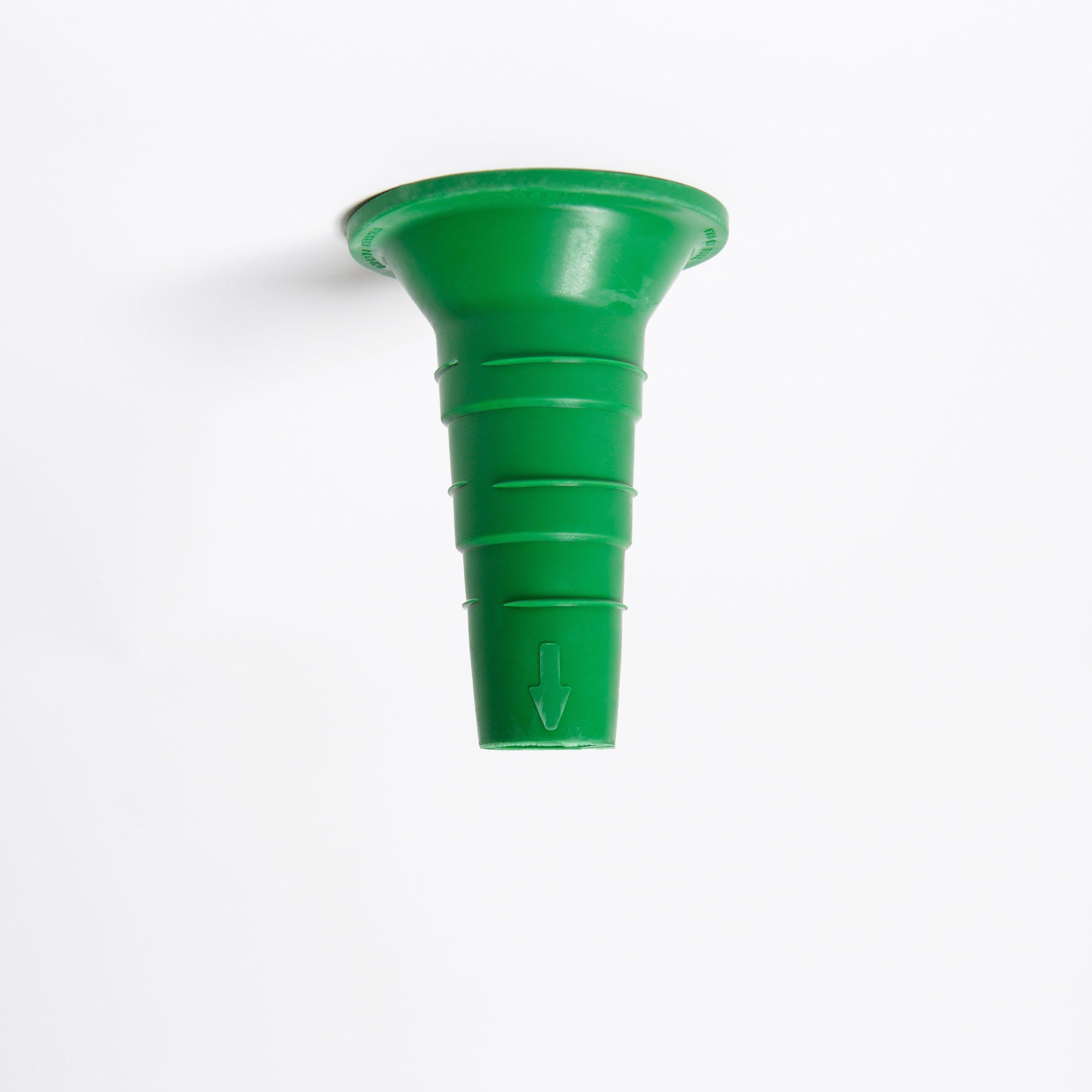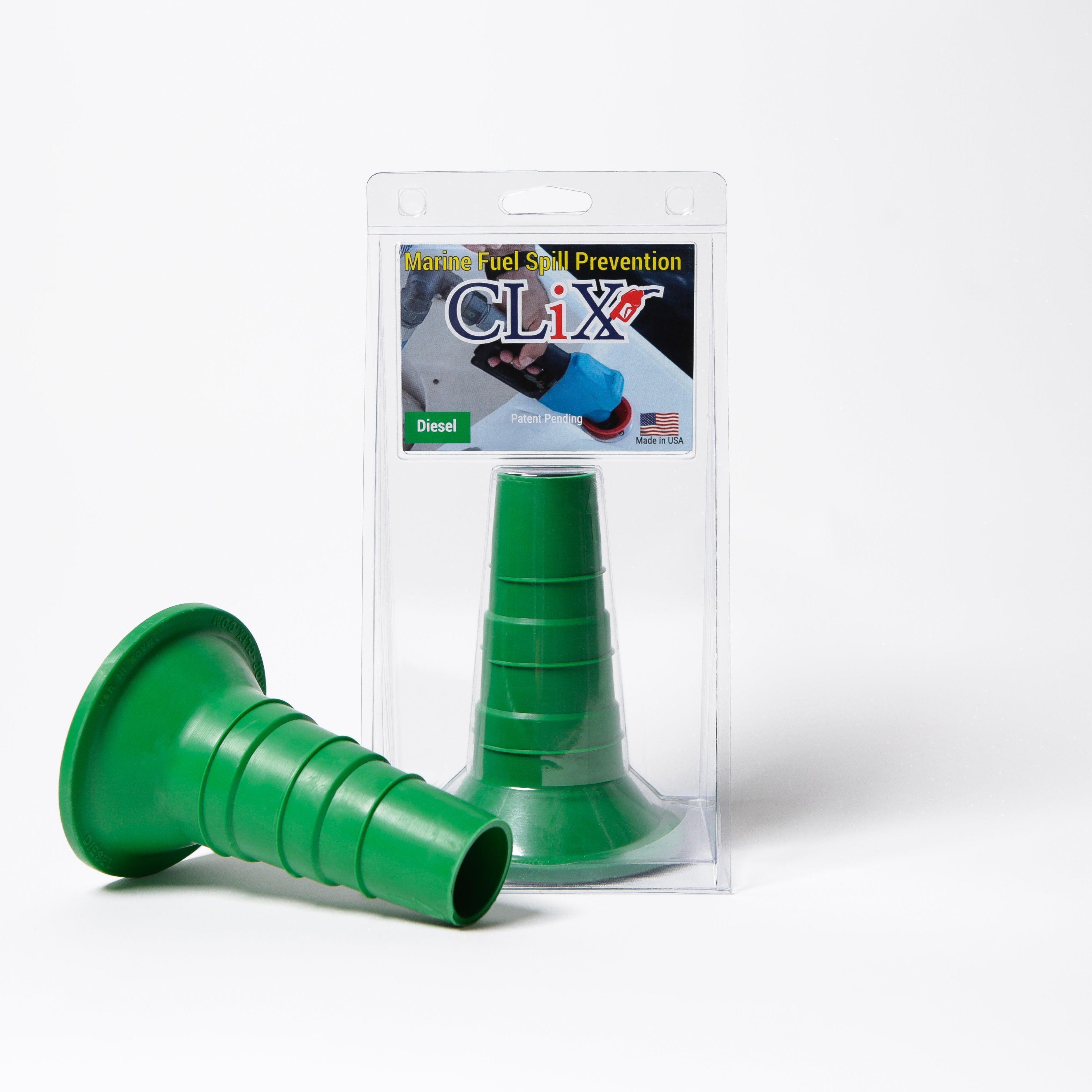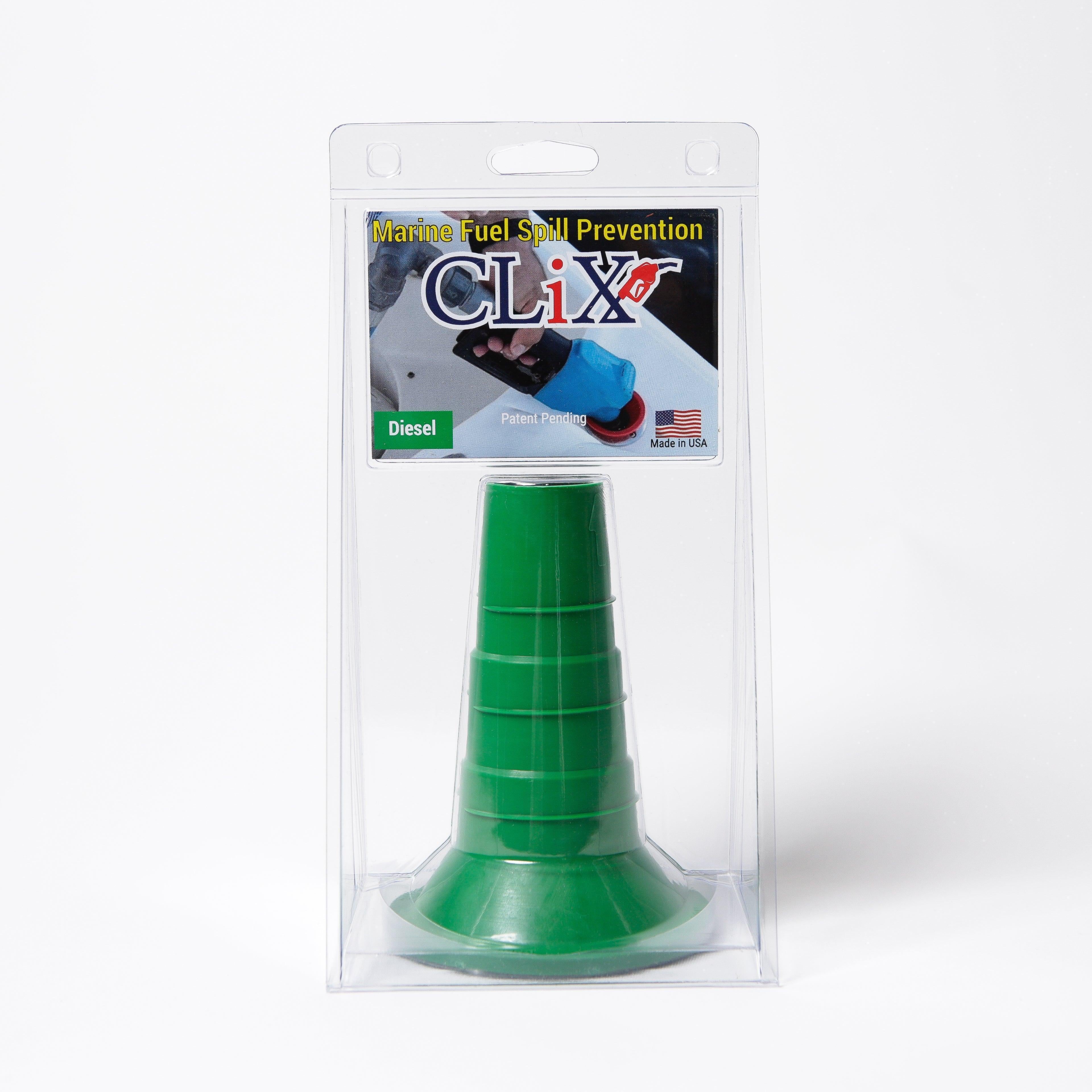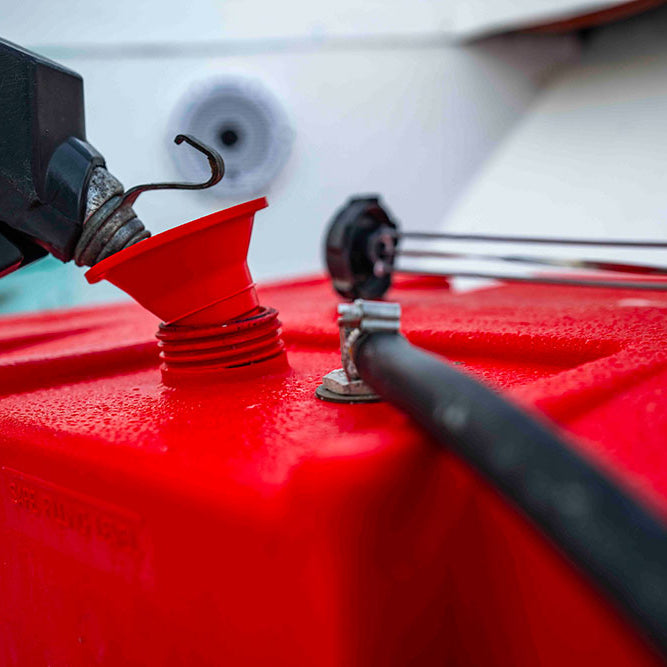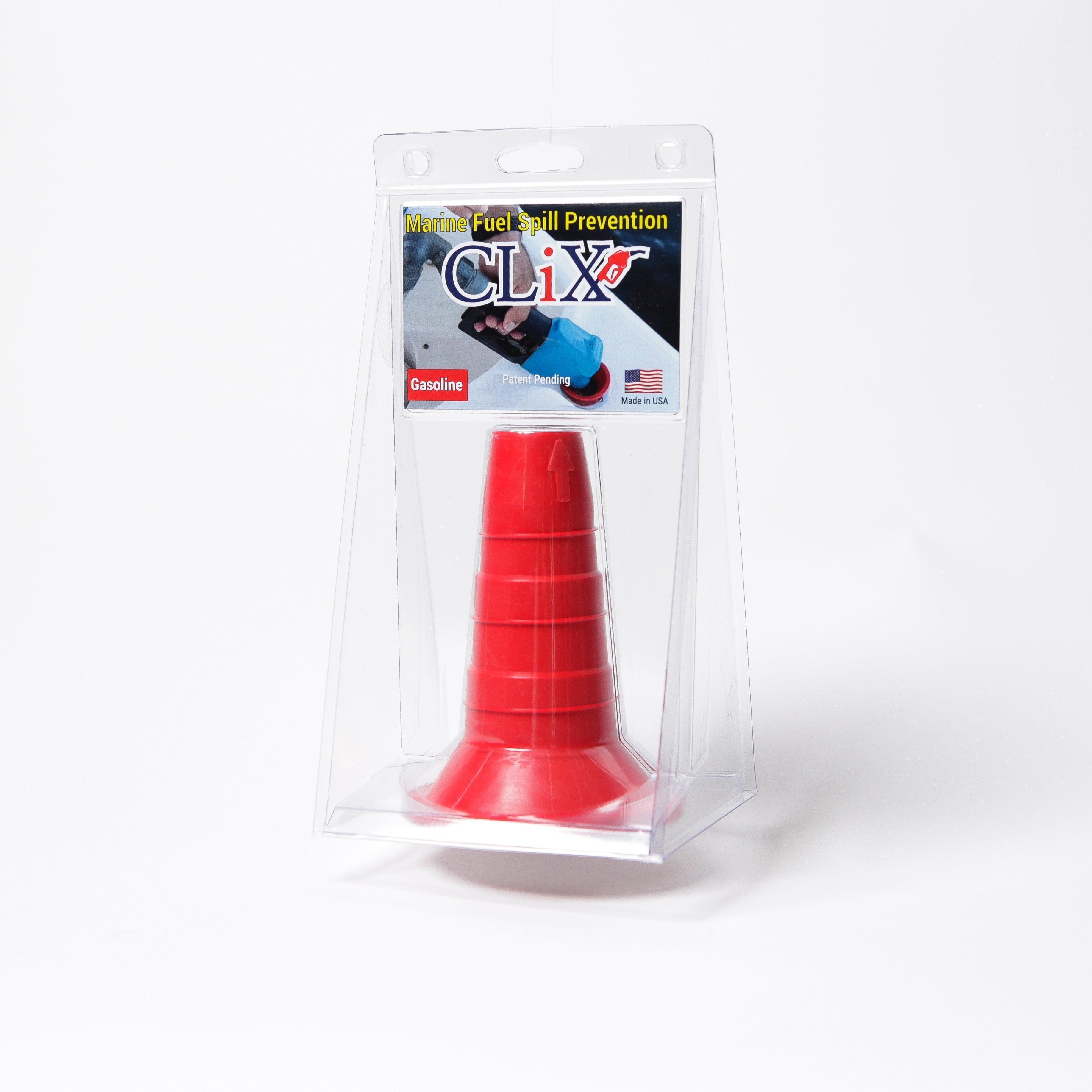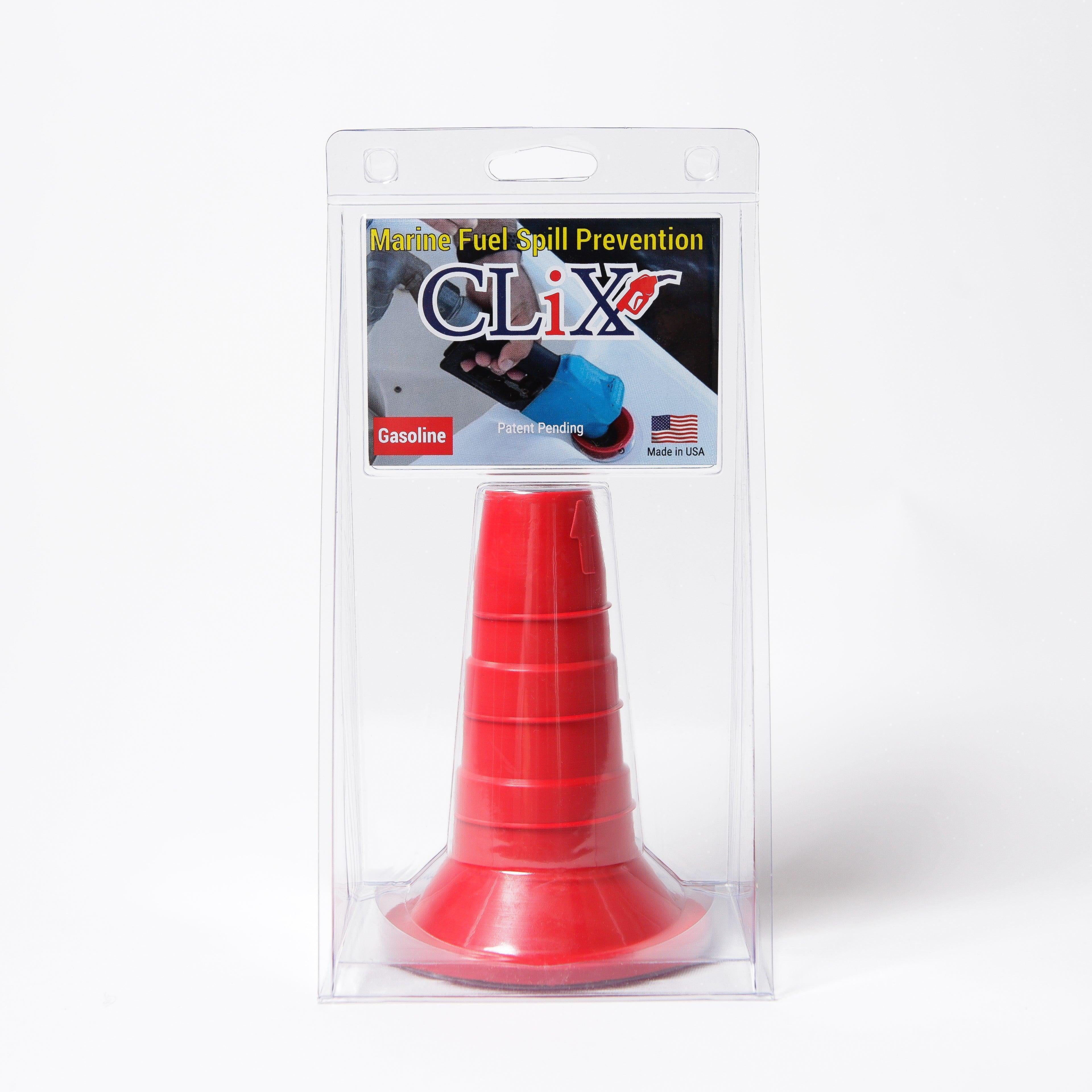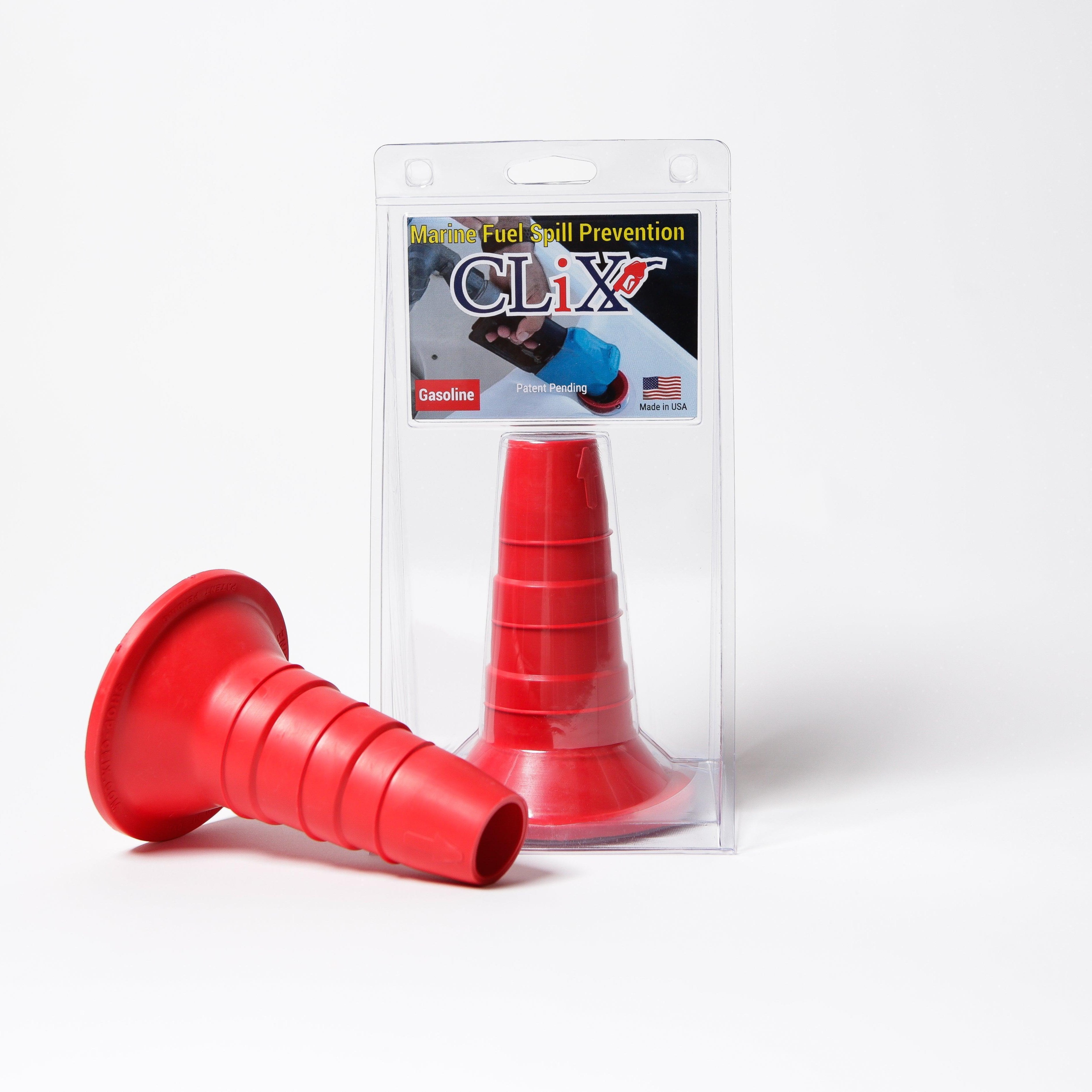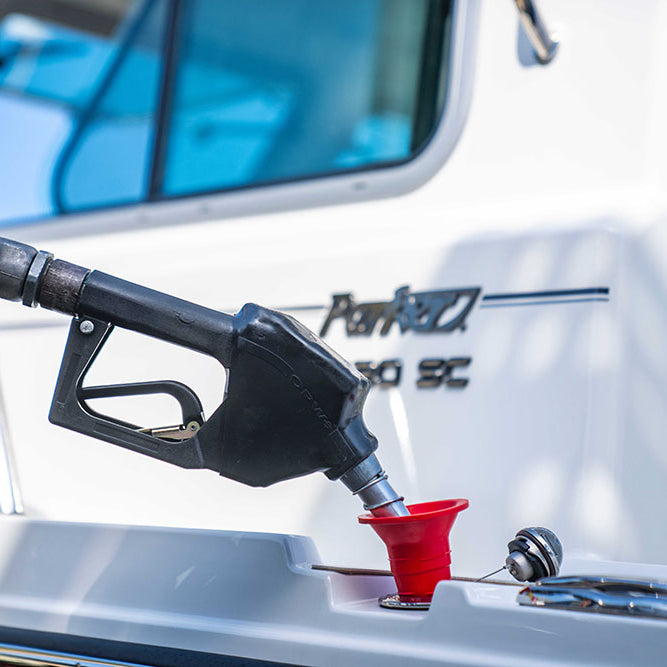In any industrial, marine, or construction setting, equipment is the backbone of productivity. But without rigorous safety protocols, it can also be the biggest liability. A comprehensive equipment safety inspection checklist is more than just a regulatory hurdle; it's a proactive strategy to prevent catastrophic failures, protect your team, and ensure operational continuity. Moving beyond simple 'tick-box' exercises, a truly effective checklist delves into the specifics of mechanical, electrical, and environmental systems.
This guide breaks down the eight most critical areas for inspection, providing actionable insights and expert tips to transform your safety program from a requirement into a core competitive advantage. We will explore everything from pre-operation visual scans to complex fluid system diagnostics and personal protective equipment (PPE) compliance. Our goal is to provide a detailed, practical framework you can immediately implement.
You will learn how to:
- Identify subtle signs of mechanical wear before they lead to failure.
- Verify the function of critical safety devices like emergency stops.
- Ensure proper documentation and record-keeping for full compliance.
This list provides the knowledge to build a robust and reliable safety culture, turning your inspection process into a powerful operational tool.
1. Pre-Operation Visual Inspection
The Pre-Operation Visual Inspection is the cornerstone of any effective equipment safety inspection checklist. It is a systematic, hands-on examination performed before starting any machinery or vehicle for the day. This initial check is designed to catch obvious defects like cracks, leaks, or loose components that could lead to catastrophic failure, injury, or environmental harm during operation. It is the first line of defense against preventable accidents.
This check involves a thorough walk-around of the equipment, focusing on its structural integrity and the condition of all visible parts. An operator should look for signs of wear and tear, corrosion, fluid leaks (oil, coolant, hydraulic fluid), and damage from previous use. It's a non-negotiable step for any organization, from construction firms inspecting excavators to transportation companies checking their fleets before departure.
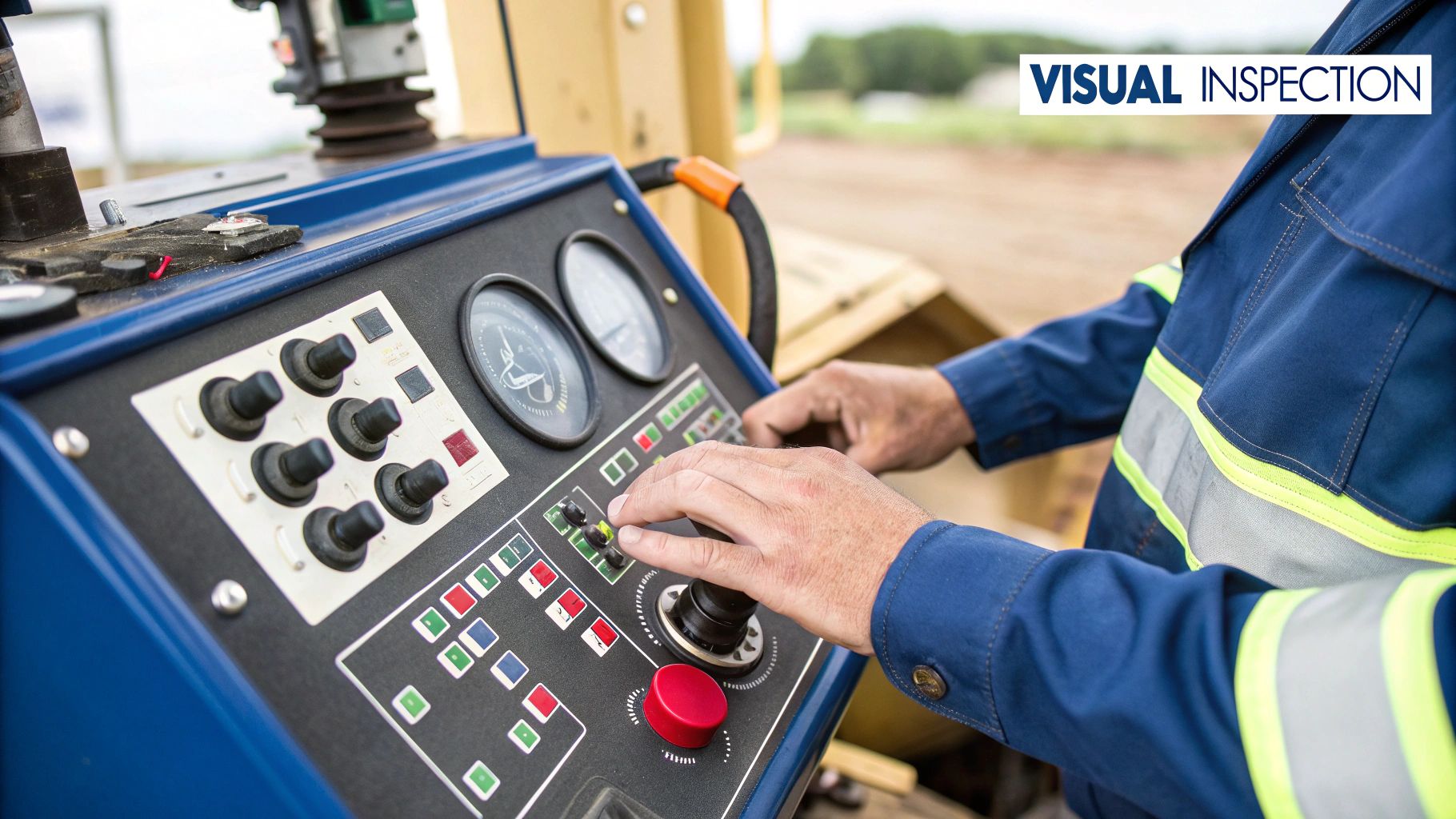
Key Areas to Inspect
- Structural Components: Check the frame, boom, and attachments for cracks, bends, or significant corrosion.
- Fluid Levels and Leaks: Look under and around the equipment for puddles or drips. Check oil, hydraulic fluid, and coolant levels.
- Tires and Tracks: Inspect for proper inflation, cuts, excessive wear, and embedded objects. For tracked vehicles, check track tension and look for damaged pads.
- Safety Guards and Devices: Ensure all safety guards, shields, and emergency stops are in place and undamaged.
- Hoses and Belts: Look for cracks, brittleness, or fraying in all visible hoses and belts.
Implementation Best Practices
To make this check effective, it's crucial to go beyond just a casual glance. Create a standardized, physical, or digital checklist specific to each piece of equipment. Train operators not just on what to look for but why it matters, connecting each checkpoint to a potential safety risk. For example, a small hydraulic fluid leak can indicate a hose is about to burst, which could cause a sudden loss of control. Empower operators to immediately tag and remove equipment from service if it fails this initial inspection, creating a culture where safety takes precedence over operational deadlines.
2. Electrical Safety Systems Check
The Electrical Safety Systems Check is a critical component of any thorough equipment safety inspection checklist, focusing on the integrity of all electrical circuits, wiring, and safety mechanisms. This inspection is designed to identify and mitigate risks of electrocution, electrical fires, arc flashes, and equipment failure. Given that electrical malfunctions are a leading cause of industrial accidents and property damage, this check is indispensable for any machinery that relies on electrical power.
This systematic review covers everything from basic wiring and connections to sophisticated safety systems like ground fault circuit interrupters (GFCIs) and emergency stops. It ensures that all electrical components are functioning as designed and meet safety standards set by bodies like the National Electrical Code (NEC) and NFPA 70E. From data centers using thermal imaging to monitor server rack connections to offshore oil platforms with extensive electrical inspection programs, this check is a non-negotiable safety protocol.
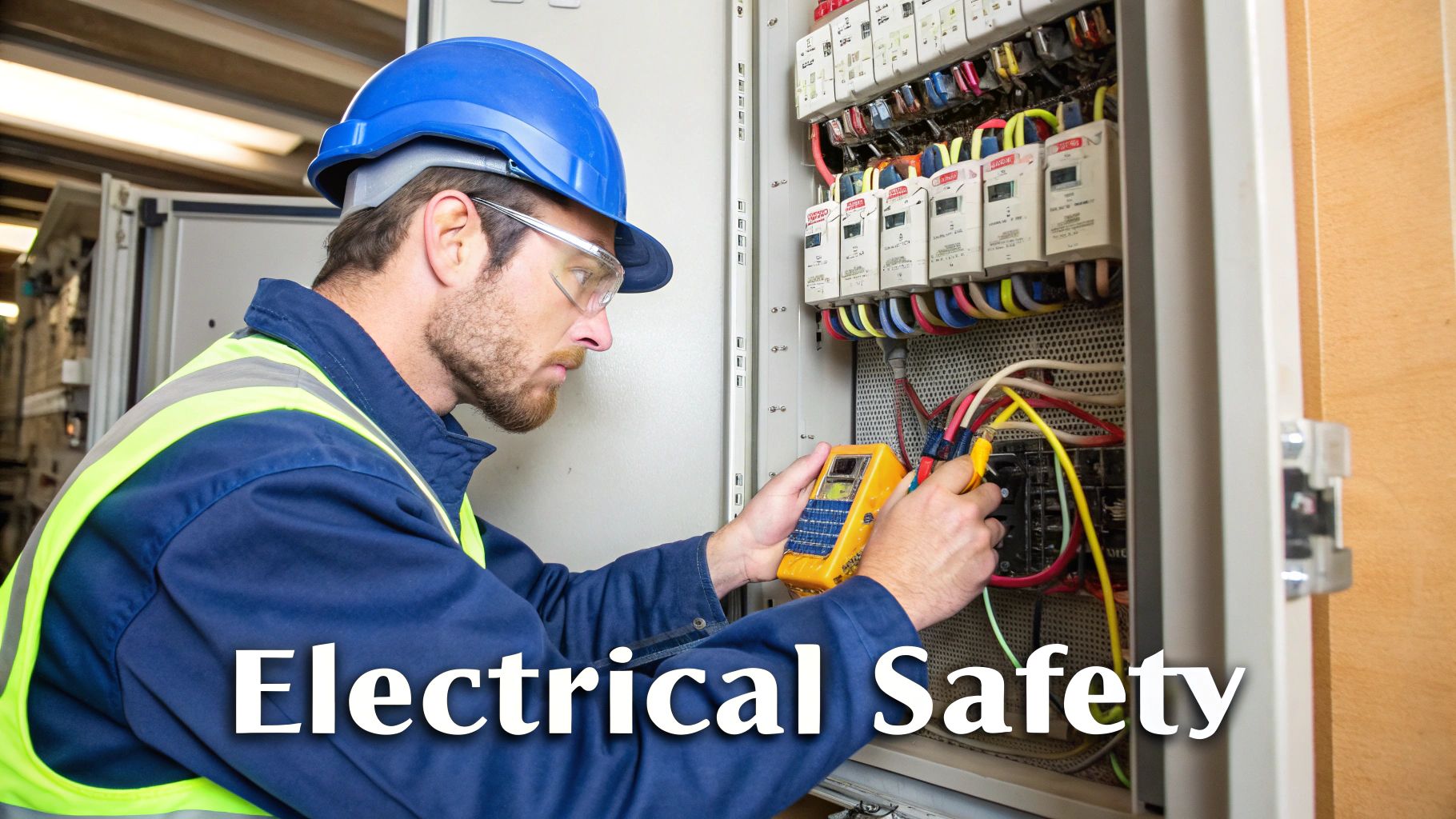
Key Areas to Inspect
- Wiring and Connections: Inspect all visible wiring for fraying, cracking, or exposed conductors. Check that all connections are secure and free of corrosion.
- Grounding Systems: Verify that the equipment's grounding system is intact and properly connected to prevent electrical shock.
- Safety Devices: Test all GFCIs using their built-in test buttons. Actuate emergency stop buttons and confirm they de-energize the equipment correctly.
- Control Panels and Cabinets: Ensure electrical cabinets are clean, dry, and securely closed. Look for signs of overheating, such as discolored wires or melted plastic.
- Lockout/Tagout (LOTO) Provisions: Confirm that the equipment has designated points for applying locks and tags to isolate energy sources during maintenance.
Implementation Best Practices
For this check to be effective, it must be performed with precision and expertise. Always use a qualified electrician for inspecting complex systems or performing diagnostics. A great practice is to implement thermal imaging scans during planned maintenance windows; this technology can detect "hot spots" at connections, which are invisible to the naked eye and indicate a potential failure point. Test GFCIs monthly, as they can fail without warning. Finally, maintain meticulous records of all electrical inspections, modifications, and repairs to track the system's health over time and ensure compliance with safety standards.
3. Mechanical Component Integrity Assessment
Beyond the surface-level visual check, a Mechanical Component Integrity Assessment dives deep into the operational heart of your equipment. This detailed examination focuses on moving parts like bearings, belts, chains, gears, and fasteners, which are often hidden from immediate view but are critical to safe operation. The goal is to proactively identify wear, fatigue, misalignment, or deterioration before these issues escalate into a sudden, dangerous mechanical failure.
This assessment is a fundamental part of a comprehensive equipment safety inspection checklist because it addresses the root causes of many catastrophic incidents. A worn bearing or a stretched chain might not be obvious during a quick walk-around, but its failure under load can cause a machine to lose control, drop a load, or eject components at high speed. It’s an essential practice for industries where equipment runs under high stress, such as manufacturing, aviation, and energy production.
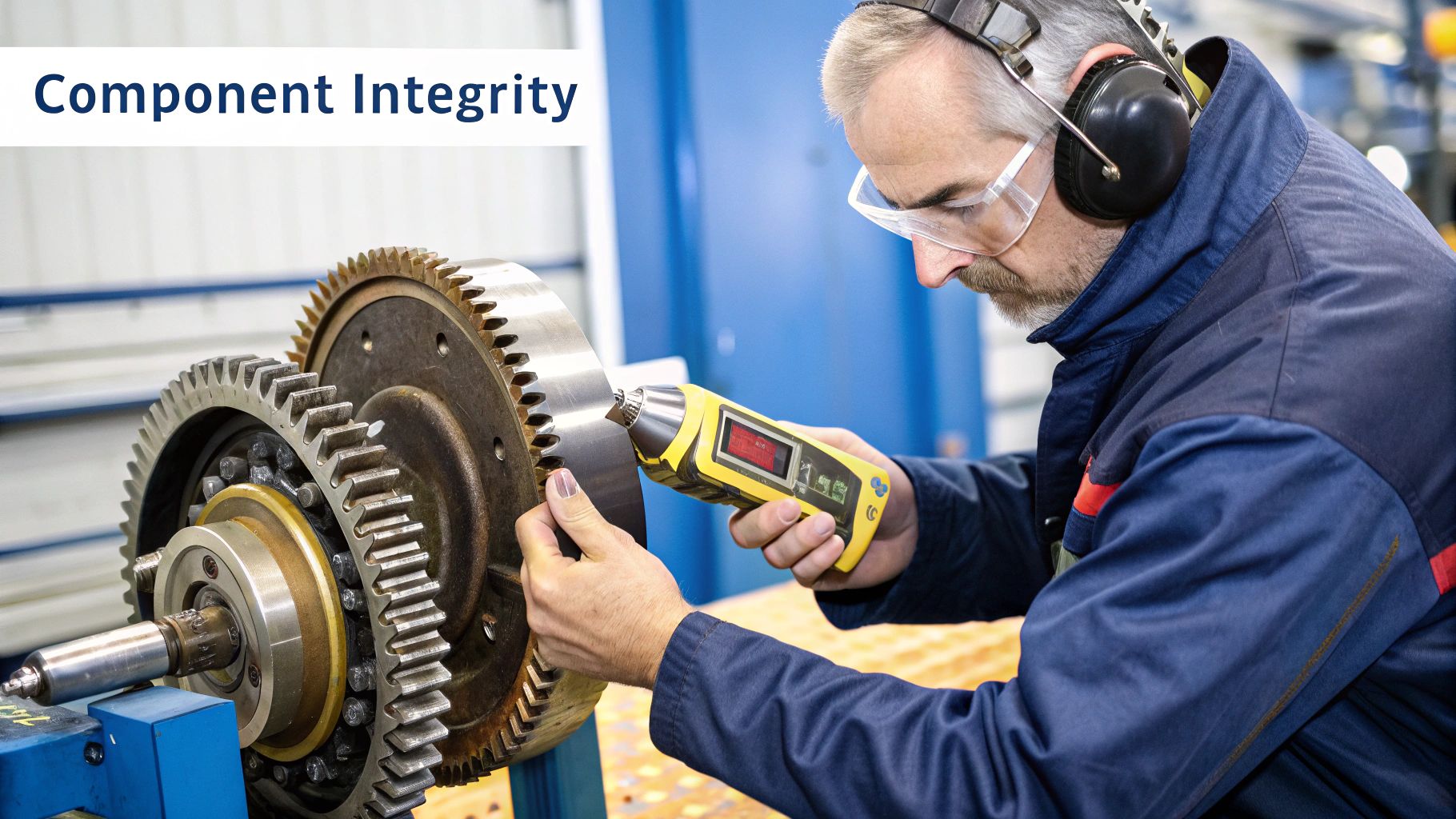
Key Areas to Inspect
- Bearings and Bushings: Listen for unusual noises like grinding or squealing. Check for excessive heat or vibration, which are clear signs of impending failure.
- Belts and Chains: Inspect for proper tension, signs of cracking, fraying, or missing teeth on belts. For chains, look for stretched links, rust, and proper lubrication.
- Gears and Drivetrains: Examine gear teeth for chipping, pitting, or excessive wear. Ensure the drivetrain is properly aligned and lubricated.
- Fasteners and Welds: Check that all bolts, nuts, and screws are tightened to the correct torque specifications. Visually inspect structural welds for any signs of cracks or stress fractures.
- Hydraulic and Pneumatic Cylinders: Look for scoring on cylinder rods and check seals for any signs of leakage, which can indicate internal wear.
Implementation Best Practices
To properly execute this assessment, you must move from a reactive to a predictive mindset. Establish baseline measurements for new or serviced components, such as vibration levels or temperature readings. This data allows you to track changes over time and predict failures before they happen. For example, wind turbine operators use continuous vibration monitoring to assess gearbox health and schedule maintenance proactively. Similarly, train your maintenance staff in advanced techniques like ultrasonic testing to find microscopic cracks in critical structural components. Always document trends in component condition and adhere strictly to the manufacturer's recommended inspection intervals and procedures.
4. Safety Device Function Verification
Safety Device Function Verification goes beyond visual checks by actively testing the systems designed to protect operators and bystanders. It involves the systematic validation of all safety-critical devices, such as emergency stops, safety interlocks, pressure relief valves, and light curtains, to ensure they function correctly under real-world conditions. This step is a non-negotiable part of any equipment safety inspection checklist because these devices are the last line of defense against catastrophic failure and severe injury.
Simply seeing that a safety device is present is not enough; it must be proven to work. For example, an automotive plant must test that a robotic arm immediately ceases movement when a safety light curtain is broken, or a chemical facility must verify that pressure relief valves open at the correct setpoint. These functional tests confirm that protective systems will perform as designed when an emergency occurs, preventing a minor issue from escalating into a major accident.
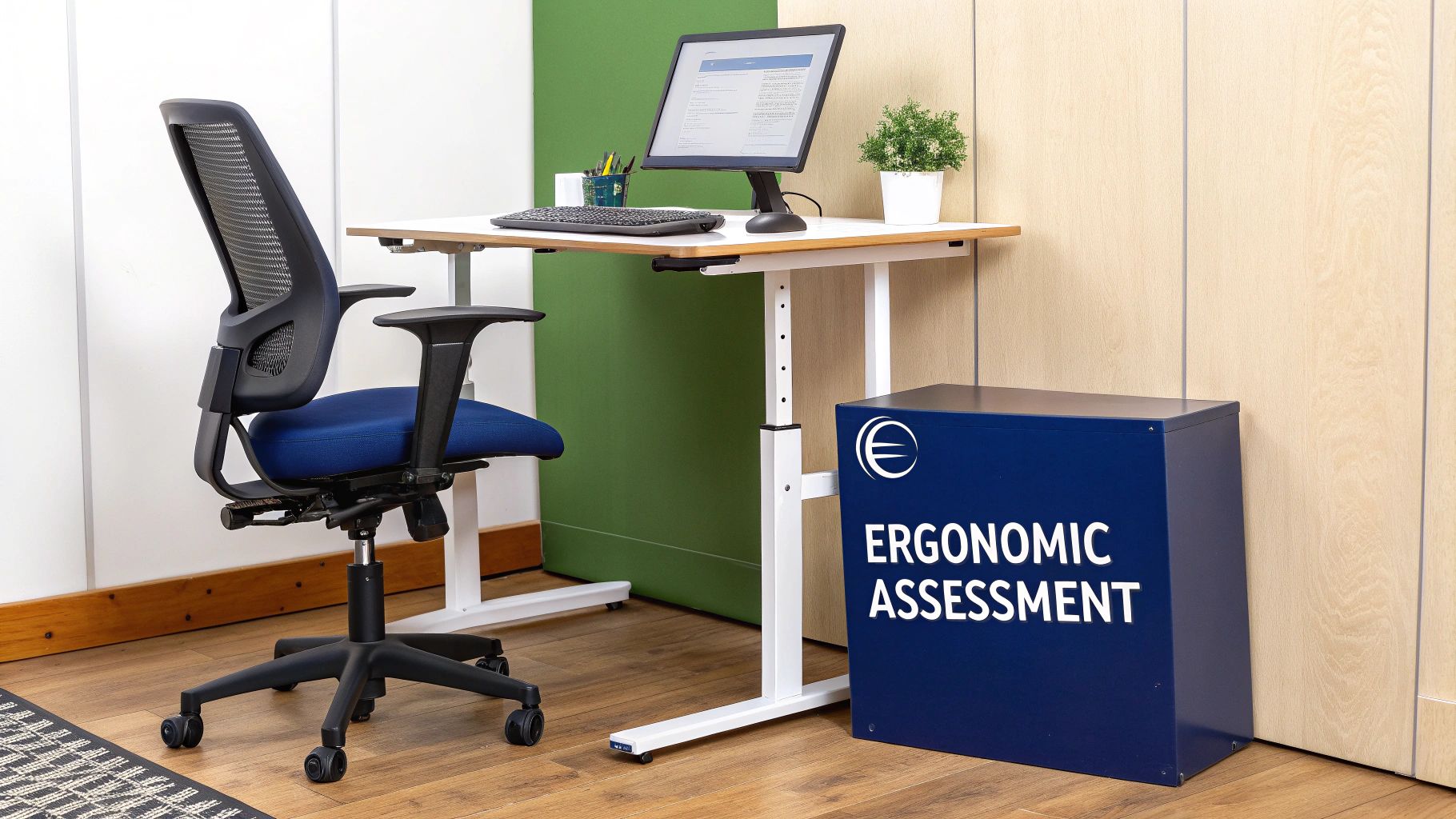
Key Areas to Inspect
- Emergency Stops: Physically press all E-stop buttons to confirm they immediately halt equipment operation.
- Safety Interlocks: Test machine guards and access doors to ensure the equipment will not operate when they are open.
- Light Curtains and Scanners: Intentionally interrupt the light beam or enter the scanned area to verify the machine stops as required.
- Pressure Relief Valves: Conduct periodic tests to ensure valves open at their specified pressure ratings to prevent over-pressurization.
- Two-Hand Controls: Confirm that both buttons must be pressed simultaneously for the machine to cycle, protecting the operator's hands.
Implementation Best Practices
Develop a formal testing schedule for all safety devices based on manufacturer recommendations, regulatory standards like OSHA and ANSI, and a thorough risk assessment. Only qualified and trained personnel should perform these tests. Beyond general safety devices, specialized systems like fire alarms require meticulous attention. For a deeper dive into their specific checks, explore an article on a comprehensive fire alarm inspection checklist to ensure total facility preparedness. Document every test, including the date, the person performing the check, and the pass/fail result. Any device that fails verification must trigger immediate action to tag out the equipment and schedule a repair, ensuring that compromised machinery is never used.
5. Fluid System Pressure and Leak Detection
Fluid System Pressure and Leak Detection is a critical component of a comprehensive equipment safety inspection checklist, focusing on the integrity of hydraulic, pneumatic, and other pressurized systems. This inspection goes beyond a simple visual check for drips; it involves systematically evaluating system pressures and actively searching for leaks that might not be immediately visible. These systems operate under immense force, and a failure can lead to catastrophic events like explosive pressure releases, equipment collapse, high-velocity fluid injections into skin, or significant environmental contamination.
This process is essential for any machinery relying on pressurized fluids or gases for operation, from construction excavators and manufacturing presses to aircraft hydraulic controls. It involves checking gauges for correct operating pressures, listening for audible hisses from air leaks, and using specialized tools to find small, hidden leaks. For example, an aircraft maintenance facility conducts rigorous hydraulic system pressure tests, while a manufacturing plant may use ultrasonic detectors to find costly leaks in its compressed air lines.
Key Areas to Inspect
- System Pressure Gauges: Verify that all gauges are functional and show pressure levels within the manufacturer's recommended operating range.
- Hoses, Lines, and Fittings: Inspect for abrasions, cuts, kinks, swelling, or signs of weeping fluid, especially around fittings and connection points.
- Cylinders and Actuators: Check for leaking seals around rods and pistons. Look for any scoring or damage on cylinder rods that could damage seals.
- Valves and Pumps: Listen for unusual noises that could indicate internal wear or failure. Check for external leaks around valve bodies and pump housings.
- Fluid Reservoirs: Ensure fluid is at the correct level and is not cloudy or contaminated, which can indicate internal system wear or water intrusion.
Implementation Best Practices
A proactive approach is key to managing pressurized systems safely. Utilize advanced tools like ultrasonic leak detectors for pneumatic systems to find non-audible leaks early, saving energy and preventing component failure. Implement a schedule for replacing hoses and seals based on the manufacturer’s recommendations or operating hours, rather than waiting for them to fail. Train personnel to recognize the subtle signs of impending failure, such as sluggish system response or a gradual drop in operating pressure over time. Empowering your team to understand and maintain these complex systems is a direct investment in a safer workplace. For those in the marine industry, understanding the specifics of fuel systems is equally vital; you can learn more about boat fuel systems on clixfueling.com.
6. Environmental and Ergonomic Hazard Assessment
An Environmental and Ergonomic Hazard Assessment extends the scope of a typical equipment safety inspection checklist beyond the machine itself to the surrounding workspace. It involves a systematic evaluation of environmental conditions like air quality and noise, alongside ergonomic factors related to how an operator interacts physically with the equipment. This assessment is critical for preventing long-term occupational illnesses and musculoskeletal injuries that aren't caused by sudden mechanical failure but by prolonged exposure to unsafe conditions.
This check ensures the work environment does not pose a hidden threat to employee health and well-being. From a loud engine causing hearing loss over time to a poorly designed operator's seat leading to chronic back pain, these hazards are just as serious as a faulty brake line. This comprehensive approach is essential in any setting, from a manufacturing plant monitoring airborne particulates to a marina ensuring proper ventilation in boat maintenance areas.
Key Areas to Inspect
- Noise Levels: Measure decibel levels around noisy machinery during typical operation to determine if hearing protection or engineering controls are needed.
- Air Quality and Ventilation: Check for dust, fumes, vapors, and adequate airflow, especially in enclosed spaces like engine rooms or workshops.
- Lighting and Visibility: Ensure work areas are well-lit to prevent trips, falls, and operational errors. Check that lighting doesn't create glare on screens or gauges.
- Ergonomics: Evaluate operator stations, controls, and seating for proper design. Look for awkward postures, repetitive motions, or excessive force required for tasks.
- Temperature Extremes: Assess for risks of heat stress or cold-related injuries, particularly in outdoor environments or engine compartments.
Implementation Best Practices
To properly integrate this assessment, conduct it during normal operating hours to get a realistic measure of conditions. For complex issues like chemical exposure or precise noise mapping, engage a certified industrial hygienist. A key principle is to prioritize engineering controls (e.g., installing sound-dampening materials) before relying on Personal Protective Equipment (PPE). Regular monitoring of high-risk areas is crucial, as is training workers to recognize and report these hazards. For those in the marine industry, understanding these broader responsibilities is key to maintaining a safe harbor. Learn more about how comprehensive environmental compliance training on clixfueling.com can support these efforts.
7. Personal Protective Equipment (PPE) Compliance Verification
While inspecting the equipment is critical, an equally important part of any safety program involves verifying the gear that protects the operator. Personal Protective Equipment (PPE) Compliance Verification is a systematic check to ensure that the correct PPE is available, properly maintained, and used correctly for the specific task and equipment. This check confirms that items like hard hats, safety glasses, gloves, and respirators are not just present but are also fit for purpose and meet regulatory standards. It's the human element of the equipment safety inspection checklist.
This verification goes beyond a simple inventory count. It involves assessing the condition of each piece of PPE, ensuring it fits the user correctly, and confirming that operators understand its limitations. A cracked hard hat or a poorly fitting respirator offers a false sense of security and can lead to severe injury or long-term health issues. From construction sites enforcing fall protection protocols to chemical labs maintaining emergency eyewash stations, verifying PPE compliance is a non-negotiable step in mitigating workplace hazards.
Key Areas to Inspect
- Availability and Condition: Confirm that all required PPE for the task is readily available and inspect each item for damage, such as cracks, tears, or signs of degradation.
- Proper Fit: Ensure that gear like safety glasses, gloves, and respirators fit the individual user correctly. Ill-fitting equipment can be ineffective or create new hazards.
- Expiration Dates: Check for and adhere to manufacturer expiration dates on items like hard hats and respirator cartridges.
- Specialized Equipment: For tasks requiring specific protection, like operating a boat, verify that specialized gear like life jackets and other marine safety items are in good condition. For more details on what to check, learn more about a boating safety equipment checklist on clixfueling.com.
- Storage: Inspect how PPE is stored. It should be kept in a clean, dry location away from sunlight, chemicals, and extreme temperatures to prevent damage.
Implementation Best Practices
Integrate PPE checks directly into the pre-use equipment inspection routine. Train employees to perform a personal inspection of their own PPE before every use and empower them to request replacements without fear of reprisal. Provide a variety of sizes for all wearable gear to guarantee a proper fit for every worker. It is also crucial to maintain meticulous records of when PPE was issued, when training was conducted, and when inspections were performed. This documentation is not just for compliance; it reinforces a culture where personal safety is valued as highly as machine maintenance.
8. Documentation and Record-Keeping Compliance
While physical checks are vital, Documentation and Record-Keeping Compliance is the administrative backbone of any robust equipment safety inspection checklist. This step involves a systematic review of all inspection records, maintenance logs, operator training certifications, and other regulatory paperwork. It ensures that safety procedures are not only being performed but are also being documented accurately, providing a clear, traceable history of the equipment's condition and maintenance over its entire lifecycle.
Effective record-keeping is crucial for demonstrating due diligence, identifying recurring maintenance issues, and ensuring accountability. It transforms inspections from isolated events into part of a continuous improvement process. Industries like aviation, where detailed aircraft maintenance logs are legally mandated, exemplify the critical role documentation plays in preventing catastrophic failures. Similarly, comprehensive record-keeping is non-negotiable in sectors with stringent oversight, such as nuclear power and medical device manufacturing.
Key Areas to Inspect
- Inspection Logs: Verify that pre-operation and periodic inspection forms are completed, signed, and dated for every piece of equipment.
- Maintenance Records: Review logs of all repairs, preventative maintenance, and parts replacements to ensure work was completed and documented.
- Operator Certifications: Confirm that all personnel operating specific equipment have current, valid training and certification records on file.
- Regulatory Filings: Check that all required permits, licenses, and compliance reports are up-to-date and easily accessible.
- Incident Reports: Ensure any past accident or near-miss reports are properly filed and that corrective actions were documented.
Implementation Best Practices
To streamline this process, implement a digital record-keeping system or a well-organized physical filing system with standardized forms. Consistency is key, so establish clear procedures for how and when documents must be completed and filed. Regularly audit your records to catch discrepancies or gaps before they become a major compliance issue. Beyond merely ticking boxes, understanding the broader benefits of meeting compliance standards can reinforce the importance of thorough documentation and a robust safety culture. Lastly, ensure all critical records are securely backed up to prevent loss from fire, flood, or digital corruption.
Safety Inspection Checklist: 8-Point Feature Comparison
| Inspection Type | Implementation Complexity 🔄 | Resource Requirements ⚡ | Expected Outcomes 📊 | Ideal Use Cases 💡 | Key Advantages ⭐ |
|---|---|---|---|---|---|
| Pre-Operation Visual Inspection | Low – simple process, relies on training | Minimal tools, quick visual access | Identify obvious defects, prevent major accidents | Daily equipment checks in construction, manufacturing, transport | Fast, cost-effective, increases operator awareness |
| Electrical Safety Systems Check | High – specialized electrical expertise required | Expensive testing tools, possible equipment shutdown | Prevents electrocution/fires, ensures electrical code compliance | Electrical systems in semiconductor, offshore, data centers | Reduces fatal accidents, protects equipment |
| Mechanical Component Integrity Assessment | High – requires diagnostic tools and expertise | Specialized equipment: vibration analysis, ultrasonic tools | Early detection of wear/fatigue, reduces downtime | Heavy machinery, turbines, steel mills, aviation | Prevents catastrophic failures, extends equipment life |
| Safety Device Function Verification | Medium to high – specialized knowledge needed | Tools for testing safety devices, possible downtime | Ensures safety devices operate correctly | Manufacturing robots, chemical plants, food processing | Prevents accidents, maintains regulatory compliance |
| Fluid System Pressure and Leak Detection | Medium – requires pressure/test equipment | Specialized leak detectors, pressure gauges | Detects leaks, prevents pressure accidents, environmental protection | Hydraulic/pneumatic systems in aviation, oil refineries | Maintains system efficiency, identifies failures early |
| Environmental and Ergonomic Hazard Assessment | Medium – specialized monitoring equipment | Sound meters, air samplers, light meters | Improves worker health, prevents long-term injuries | Noise/air quality monitoring in manufacturing, offices | Enhances comfort, reduces compensation claims |
| PPE Compliance Verification | Low to medium – relatively straightforward | PPE inventory, inspection tools | Ensures proper PPE use, protects individual workers | Construction sites, healthcare, chemical labs | Quick, inexpensive safety measure, legally required |
| Documentation and Record-Keeping Compliance | Medium – requires organized systems | Digital or paper record systems | Ensures audit readiness, enables predictive analysis | Highly regulated industries like aviation, nuclear, medical | Demonstrates due diligence, supports root cause analysis |
Integrating Your Checklist into a Culture of Safety
A comprehensive equipment safety inspection checklist is more than just a list of tasks to complete; it is the cornerstone of a proactive and resilient safety culture. Throughout this article, we’ve explored the eight essential pillars of a robust inspection process, from the initial pre-operation visual check to meticulous documentation and record-keeping. Each step, whether it’s verifying the integrity of mechanical components or ensuring safety devices function correctly, serves a critical purpose in preventing accidents, protecting personnel, and safeguarding valuable assets.
The true value of this framework, however, emerges when it moves from a static document to a dynamic, living part of your daily operations. Mastering this process is not about rote memorization but about fostering an environment where safety is a shared responsibility. When operators are empowered to perform thorough fluid system checks and identify potential leaks before they become major hazards, you build a powerful first line of defense. Similarly, diligent environmental and ergonomic assessments demonstrate a deep commitment to the well-being of your team, which in turn boosts morale and operational focus.
From Checklist to Culture: Actionable Next Steps
Transforming your checklist from a requirement into a cultural value requires deliberate action and continuous reinforcement. Here are the key steps to embed these principles into your organization:
- Empower Your Team: Encourage every individual, from seasoned operators to new hires, to speak up without hesitation if they spot a potential hazard. Create clear "stop work" authority that allows any employee to halt an operation they believe is unsafe. This empowerment is the ultimate sign of a trusting and effective safety culture.
- Embrace Continuous Improvement: Your equipment safety inspection checklist should never be considered "finished." Use the data from your inspections, including near-miss reports and identified hazards, to regularly review and refine your checklist. Are there recurring issues? Are certain checks redundant? A responsive and evolving checklist is a powerful tool.
- Invest in Smarter Tools: Reinforce your commitment to safety by investing in equipment that inherently reduces risk. For example, adopting solutions like spill-proof fueling systems not only prevents environmental contamination but also eliminates a significant fire and slip hazard, directly supporting the goals of your fluid system checks.
- Broaden Your Safety Perspective: A truly robust safety program integrates multiple facets of risk management. Just as this checklist addresses equipment, a holistic approach also considers physical security and access control. To truly embed safety, consider how other comprehensive checklists, such as an ultimate construction site security checklist, contribute to a broader safety culture.
By viewing your equipment safety inspection checklist not as a final destination but as a continuous journey, you create a workplace that is not only compliant but genuinely safe. This commitment protects your people, your equipment, and your reputation, paving the way for a more resilient and productive future.
Ready to elevate your fuel handling safety and environmental compliance? CLiX Fueling Solutions offers innovative, spill-proof technology designed to make fueling operations safer and cleaner. Explore how CLiX Fueling Solutions can enhance your equipment safety inspection checklist by eliminating fuel-related hazards at the source.


